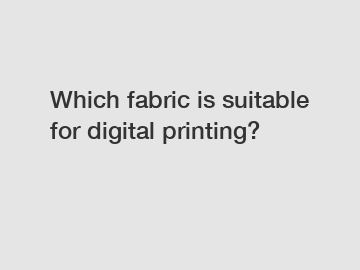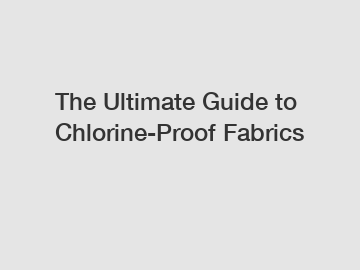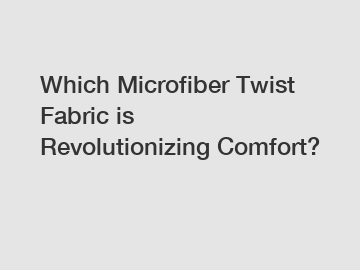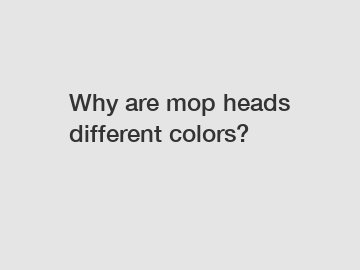Which fabric is suitable for digital printing?
Which fabric is suitable for digital printing?
Digital printing has revolutionized the world of textile design, allowing for intricate patterns, vibrant colors, and high-quality images to be transferred onto fabric with ease. However, not all fabrics are created equal when it comes to digital printing. In order to achieve the best results, it's important to choose the right fabric for the printing process. Let's explore the characteristics of different fabrics and determine which one is most suitable for digital printing.
1. Natural Fabrics:

Natural fabrics such as cotton and silk have long been favored for their softness, breathability, and natural dyes. When it comes to digital printing, cotton is an excellent choice. Its smooth surface allows ink to be absorbed effectively, resulting in vibrant and detailed prints. Cotton fabric is also readily available and affordable, making it a popular choice for many designers. Silk, on the other hand, can be slightly more challenging to print on due to its delicate and slippery texture. However, with the proper preparation and expertise, silk can produce stunning, high-end prints that are sought after in the fashion industry.
2. Synthetic Fabrics:
Synthetic fabrics like polyester and nylon have gained popularity in recent years due to their durability and versatility. Polyester, in particular, is widely used in digital printing due to its great affinity for ink. It has a smooth and hard surface that allows for excellent color reproduction and sharp details. The only drawback of polyester is its lack of breathability, which may not be suitable for certain applications like clothing worn in hot climates. Nylon, on the other hand, is more challenging to print on due to its elasticity and tendency to stretch. However, with proper tensioning and pre-treatment, nylon can yield impressive results for digital prints.
Additional reading:Is 60% cotton 40% polyester good?
What are kitchen wipes for?
The Ultimate Guide: What Is Cotton Fabric Made Of?
How are these dusters useful?
Leather Handbag Sets: A Timeless Combination of Style and Functionality
Understanding Epoxy Fiberglass Sheets and Their Applications
Exploring the Versatility and Comfort of Brushed Nylon Fabric
3. Blended Fabrics:
Blended fabrics are a combination of natural and synthetic fibers and offer unique properties from both worlds. For example, a cotton-polyester blend combines the softness and breathability of cotton with the ink-friendly characteristics of polyester. Blends can provide the best of both worlds, resulting in vibrant prints with added durability and wrinkle resistance. However, it's important to note that the ratio of the blend can impact the printing outcome. Higher percentages of synthetic fibers generally produce better results, but it's essential to test different blends to achieve the desired effect.
4. Specialty Fabrics:
Apart from the conventional fabric options, there are also specialty fabrics specifically designed for digital printing. These fabrics are engineered to optimize color vibrancy, ink absorption, and overall print quality. For instance, fabric options like microfiber and lycra are specifically tailored to meet the needs of athletic wear and swimwear, where stretchability and moisture-wicking properties are crucial. Similarly, fabrics like canvas and linen are ideal for home decor items or art reproductions due to their texture and robustness.
In conclusion, choosing the right fabric is vital for achieving exceptional results in digital printing. Cotton and polyester are the top choices due to their ink absorption ability and surface smoothness, respectively. Blended fabrics offer a compromise between different properties while specialty fabrics cater to specific requirements. Ultimately, the decision depends on the intended application and desired outcome. By selecting the most suitable fabric, designers can unleash their creativity and bring their visions to life with stunning digital prints.
Are you interested in learning more about cvc cotton gsm, uniform material fabric, greige fabric? Contact us today to secure an expert consultation!
Additional reading:Unleashing Performance and Comfort with Sportswear Fabrics
How do I choose the right sweat towel?
What is FR Fabric?
What Fabrics Are Inherently Flame Retardant?
What fabric is 55 cotton 45 polyester?
Which microfiber diamond product offers the best value for money at the purchase stage?
Unleashing the Vibrant Glow of 310gsm Fluorescent Yellow Fabric!
163
0
0
Related Articles
-
Which Cheap Outdoor Carpet Resists Stains Best?
Outdoor carpets are a fantastic way to enhance the beauty and functionality of an outdoor space.
190
0
0
-
231
0
0
-
169
0
0
-
179
0
0
-
Which Flame Resistant Fabric By The Yard is the Safest Choice for Your Loved Ones?
Which Flame Resistant Fabric By The Yard is the Safest Choice for Your Loved Ones?
192
0
0
-
178
0
0
-
210
0
0
-
137
0
0










Comments
All Comments (0)